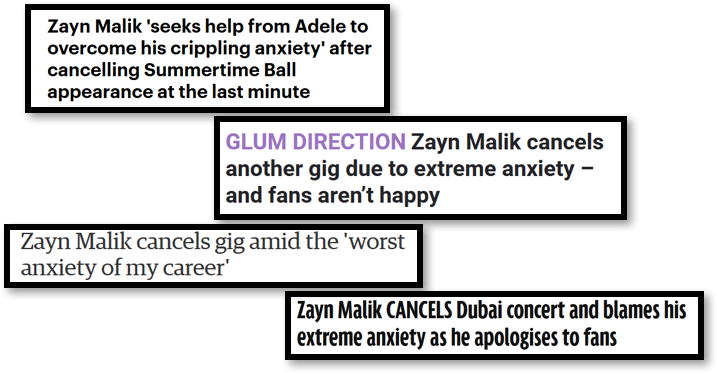High-profile cases bring mental health into the media spotlight. Where efforts to reduce stigma are concerned, such instances are often seen as golden opportunities. But is there more that could be done to elevate the level of discussion at these moments of heightened public interest?

Headlines from UK newspapers regarding Zayn Malik’s anxiety-related show cancellations (from top: Daily Mail; Sun; Guardian; Mirror)
Recent months have seen headlines littered with references to Zayn Malik’s (One Direction star, recently gone solo) ‘crippling’ anxiety. The news was triggered after Malik publicly ‘confessed’ to his anxiety surrounding live performances. Malik has allegedly struggled with nerves throughout his career and is now seeking help from professionals rumoured to have previously worked with Adele on similar grounds.
— zayn (@zaynmalik) June 11, 2016
Zayn Malik has 20.3 million followers on Twitter and received a wealth of support on the social media platform as news of his anxiety spread. Fellow celebs responded in solidarity alongside members of the general public from across the world – many sharing their own personal stories and experiences of anxiety.
Beneath the flurry of sensationalising media headlines, there is no doubt that the publicity around Malik’s statement raised the possibility, if only temporarily, of a more open conversation about anxiety and mental health in general. Still, what was missing from the conversation was any mention of the fact that anxiety is specific to context – and that Malik’s anxiety, seemingly specific to stage fright, is distinct from other types of anxiety, and indeed anxiety disorders.
“1 in 4 people in the UK will experience a mental health problem each year, with anxiety disorders being among the most common. Despite this high prevalence, general awareness about what anxiety disorders actually are, and who they affect, is relatively low”
Anxiety is a very broad term. It can be used to describe common feelings of nervousness and worry, experienced frequently, and often beneficially, by most people in the general population. Anxiety is also a clinical term, used to describe a set of less common psychiatric symptoms, relating to excessive fear and apprehension. There are numerous types of anxiety disorders, including generalised anxiety disorder, social anxiety disorder, post-traumatic stress disorder, and specific phobias. Anxiety disorders can be difficult to control and symptoms are not necessarily triggered explicitly in response to threatening or fearful events (such as performing live to 20,000 screaming fans).
1 in 4 people in the UK will experience a mental health problem each year, with anxiety disorders being among the most common. Despite this high prevalence, general awareness about what anxiety disorders actually are, and who they affect, is relatively low. The situation is not helped by the lay usage of ‘anxiety’ as an umbrella term to describe a wide spectrum of emotions and disorders.
So, while Zayn Malik (rated number five on Glamour magazine’s 2016 ‘100 Sexiest Men’) tweeting about his difficulties with anxiety may have paved the way for a mainstream discussion, there remains a need to bring in better information at such times. The next step could be starting to address which *type* of anxiety is being talking about. Introducing stronger definitions of anxiety in media headlines and social media posts could help to raise awareness and improve education on the mental health problems commonplace, and on the rise, within our society today.


[…] sadness and loss of pleasure (for depression) and fear and worry (for anxiety). As discussed in a previous blog, anxiety disorders come in all shapes and sizes, and to further confuse things, we all experience […]